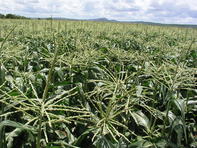
Scientific name: Zea mays L. var. rugosa
Common Name: Sweet Corn
Plant Description
Maize is thought to have originated in Central America and was first planted in Africa in the 16th and 17th Century. Sweet corn maize is a mutant of maize that contains at least double the sugar content of traditional maize.
It is a grass and has a strong, firm stem. The blades or leaves of sweet corn, develop from the stem and the flower or tassel forms at the top of the stem, which pollinates the ears or cobs that grow out of the lower nodes at the base of the leaves. The sweet corn plant bears one to two corn cobs that form from the base of the ear leaves.
Sweet Corn Uses
Sweet corn is eaten fresh, boiled or over a barbecue (sweet corn cobs or corn-on-the-cob). The kernels are also stripped from their cob and frozen immediately after harvest and also tinned.
Soil Requirements and Preparation

Sweet corn requires well drained sandy loam to loam soils with good levels of organic content and a pH of between 6 and 7 is best. Start preparing your soil well in advance of planting, or soon after the previous sweet corn crop, if the ground to be planted, was previously cultivated.
About 3 to 4 months before planting, any organic compost and manures required can be applied to the area and can then be ripped and ploughed to a depth of 500 mm to mix past crop residue, composts and weed residue into the soil. Thereafter sow a green cover crop and lightly till seeds into the top 10 mm of soil.
Once the cover crop is out and growing, spread 100 kg per hectare of LAN to boost green cover crop growth. Two months before planting, take soil samples as instructed by the laboratory and have them analysed to determine soil nutrient requirements. About three to four weeks before planting sweet corn, once the soil analysis has been received back, the cover crop is mowed down and now the additives like lime for pH correction, gypsum for calcium, further compost and manure for organics should be applied and worked into the soil by ploughing them into the top 500 mm of soil.
Seven days before planting, the soil is worked for the final time and this is normally done with a disk harrow, working the top 20 cm of soil, levelling the plant area, and ridding it of any weeds that may still be present.
The pre-plant fertiliser and trace elements like Boron and Zinc applications prescribed by the soil analysis, should also be worked into the top soil at this time. After this the planting area is ready to receive the sweet corn seed.
Climate
Sweet corn is a warm climate crop and is frost sensitive. It does best when temperatures range from 18°C to 28°C.
For seeds to germinate successfully and emerge uniformly the soil temperatures should be 16°C plus. Sweet corn's growth, cob and kernel development is adversely effected when temperatures drop below 10°C or exceed 35°C.